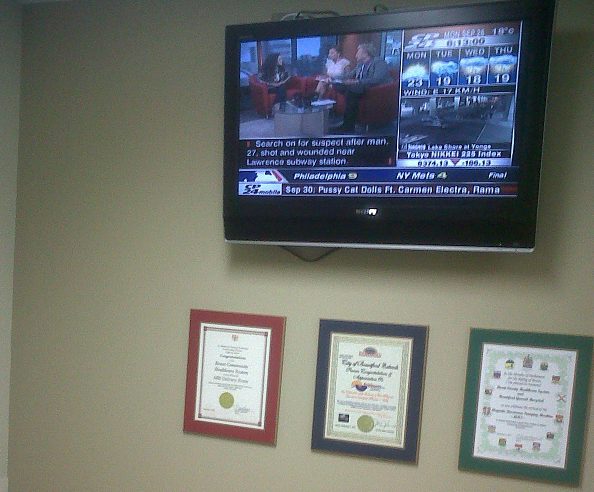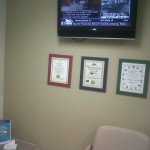From a technological point of view there is nothing wrong with the way our hospitals have changed over the past thirty years but what about from the viewpoint of a person? A real, honest to gosh person. The hospital calls these folks patients or family members/visitors, but I think they must have a secret name for them too: consumers.
Let’s be honest- There is little in the way of real consumer value in our hospitals. Even before you set foot, cane or wheelchair through the front door you have to find somewhere to leave your vehicle. And just like an airport- parking costs are typically fifteen dollars a day. And what about that once staple of stand-up comedy topics- crappy hospital food? If it isn’t anymore, there certainly was a time when hospital cafeteria meals- just like airline meals- were cultural icons. In the hospitals I have visited recently, the cafeteria is slowly but surely being turned into something else…..monitors ready to dull your brain and feed you big corp.
On Monday I spent several hours at Brantford General Hospital’s C Wing. For most of that time, I’d only been on two floors and I’d already found two Tim Horton’s counters- complete counters mind you, not just a kiosk window offering a paper cup of coffee but something offering full breakfast sandwiches and lunch menu items. So why would anyone want to visit the hospital cafeteria? And if they did would they even be successful in finding the cafeteria? I could not find a sign pointing the way but Tim Horton’s were instantly visible and both perched in prime retail positions directly at or near an outside entrance. Starbucks take note.
While I was enjoying my double – double I discovered that my wifi usb stick did not work in the MRI waiting area. I moved around to no avail. I decided to let my laptop search for a public access node and I was successful in discovering that the hospital offers public internet access. With a credit card, a patient or a family member can spend upwards of $22.54 for one week of internet access or $11.24 for one day or part of a day. I was beginning to feel like a consumer. (note: these costs from September 2011)
Visiting is getting expensive.
If I need to complete work duties while I’m waiting for a hospital appointment or waiting to visit a patient, I’ve already spent 15$ on parking, $1.60 on a coffee and $11.24 for internet access. That’s $27.84 and there’s still lunch to consider if things are delayed. I decide to give up on the world wide web and look instead for something to read. Then I realize that there isn’t any reading material. Not a Maclean’s, National Geographic or even a Reader’s Digest. Instead there are two screen monitors broadcasting CP24 news , ticker tapes and car commercials into each waiting area. Not exactly the most calming environment. I stand up and walk twenty feet towards x-ray waiting area 1. There is a small mass of people sitting and staring at the side-by-side flat screen monitors. From my perspective it is terrifyingly cold and stark. It is a scene from Orwell’s 1984 and I want to shake each one of them and tell them to stop. I want to tell them to pull out their corporate i.v. but I come to my senses. (this is only television after all right?) These people love t.v. The patient beside me whisper’s “t.v. keeps everyone’s mind off of their hospital stay”. For the Silo, Jarrod Barker.




Patients are lost in our health care system
For way too long, Ontario patients and families have been getting lost in our health care system, falling through the cracks, and waiting too long for care. This obviously can have a negative impact on the well-being of those involved, as well as their loved ones.
The health care system is facing capacity pressures. It does not have the right mix of services, beds, or digital tools to be ready for a growing and rapidly-aging population – a population with more complex care needs. Problems range from hallway healthcare, to wait lists, to poor value for money, and to poor patient experience.
Essentially, Ontario’s health care system is on life-support. Patients are forgotten on wait lists. More than 1,000 patients are receiving care in hallways every day and the average wait time to access a bed in a long-term care home is 146 days. That’s a 300 per cent increase from five years ago.
Too much time and attention is spent propping up a fragmented system. And far too many people believe it is the patient’s or the family’s job to navigate this complicated system during what is already one of the most traumatic and stress-filled periods in their lives.
Ontario currently has a large network of provincial and regional agencies, clinical oversight bodies and 1,800 health service provider organizations. This creates confusion for both patients and providers trying to navigate the maze.
The people of Ontario deserve a connected health care system that puts their needs first. At the same time, they deserve a system that is sustainable and accessible for all patients and their families, regardless of where you live, how much you make, or the kind of care you require.
As our government brings forward desperately needed and overdue improvements to health care, Ontarians will continue to access reliable service through OHIP. The goal is to improve the health system so that people have access to faster, better coordinated public health care where and when it is needed.
In the province of Ontario, care is not patient centered – care is system driven. And that’s the problem. In the past, government has not done enough to ensure the health care system is sustainable.
Our system is in need of dire change after years of government merely tinkering around the edges.
People feel their health care system and government are not working together. Over the last five years, Ontario has spent 30 per cent more than the Canadian average on administration. But people have not seen a 30 per cent improvement in care.
Right now care is fragmented, particularly at transition points, for example, from hospital to home care. Patients, families and caregivers experience frequent gaps in care, and have to reiterate their health concerns over and over again, because of a lack of digital tools and care continuity. One of the most frustrating aspects is that Ontario is home to some of the world’s best doctors, nurses, and health care teams. They work very hard to provide the best possible care in a publicly funded system.
And while universal access to publicly-funded health care is not up for debate, the structure and effectiveness of our system is now on the table for discussion. We need a patient-centered, well-coordinated publicly-funded health care system in Ontario.
Toby Barrett MPP Haldimand-Norfolk